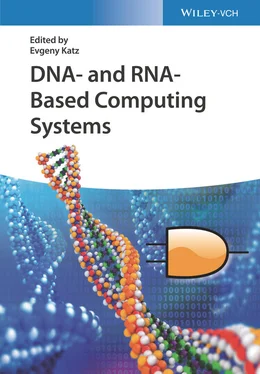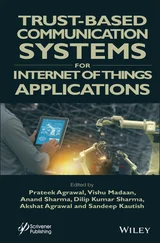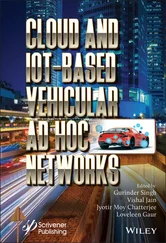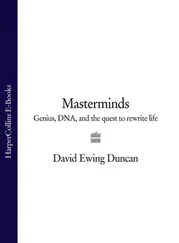36 36 Pita, M., Minko, S., and Katz, E. (2009). J. Mater. Sci. ‐ Mater. Med. 20: 457–462.
37 37 Katz, E. and Minko, S. (2015). Chem. Commun. 51: 3493–3500.
38 38 Katz, E. (2010). Electroanalysis 22: 744–756.
39 39 Okhokhonin, A.V., Domanskyi, S., Filipov, Y. et al. (2018). Electroanalysis 30: 426–435.
40 40 Filipov, Y., Gamella, M., and Katz, E. (2018). Electroanalysis 30: 1281–1286.
41 41 Gamella, M., Privman, M., Bakshi, S. et al. (2017). ChemPhysChem 18: 1811–1821.
42 42 Gamella, M., Zakharchenko, A., Guz, N. et al. (2017). Electroanalysis 29: 398–408.
43 43 Katz, E., Pingarrón, J.M., Mailloux, S. et al. (2015). J. Phys. Chem. Lett. 6: 1340–1347.
44 44 Katz, E. (2019). Enzyme‐Based Computing Systems. Wiley‐VCH.
45 45 Watson, J.D. and Crick, F.H.C. (1953). Nature 171: 737–738.
46 46 Micklos, D. and Freyer, G. (2003). DNA Science: A First Course, 2e. New York: Cold Spring Harbor Laboratory Press.
47 47 Calladine, C.R., Drew, H., Luisi, B., and Travers, A. (2004). Understanding DNA: The Molecule and How It Works, 3e. San Diego, CA: Elsevier Academic Press.
48 48 Douglas, K. (2017). DNA Nanoscience. Boca Raton, FL: CRC Press.
49 49 Fitzgerald‐Hayes, M. and Reichsman, F. (2009). DNA and Biotechnology, 3e. Amsterdam, Imprint: Academic Press: Elsevier.
50 50 Boneh, D., Dunworth, C., Lipton, R.J., and Sgall, J. (1996). Discrete Appl. Math. 71: 79–94.
51 51 Rozen, D.E., McGrew, S., and Ellington, A.D. (1996). Curr. Biol. 6: 254–257.
52 52 Eghdami, H. and Darehmiraki, M. (2012). Artif. Intell. Rev. 38: 223–235.
53 53 Ogihara, M. and Ray, A. (2000). Nature 403: 143–144.
54 54 Parker, J. (2003). EMBO Rep. 4: 7–10.
55 55 Mehrotra, A. (2015). Int. J. Latest Technol. Eng. Manage. Appl. Sci. (IJLTEMAS) 4 (12): 62–67.
56 56 Adleman, L.M. (1998). Sci. Am. 279 (2): 54–61.
57 57 Lawler, E.L., Lenstra, J.K., Rinnooy Kan, A.H.G., and Shmoys, D.B. (eds.) (1995). The Traveling Salesman Problem: A Guided Tour of Combinatorial Optimization. Chichester: Wiley‐Interscience.
58 58 Laporte, G. (1992). Eur. J. Oper. Res. 59: 231–247.
59 59 Applegate, D.L., Bixby, R.E., Chvátal, V., and Cook, W.J. (2006). The Traveling Salesman Problem – A Computational Study. Princeton, NJ: Princeton University Press.
60 60 Reif, J.H. (1999). Algorithmica 25: 142–175.
61 61 Kumar, S.N. (2015). Am. J. Nanomater. 3 (1): 1–14.
62 62 Moe‐Behrens, G.H.‐G. (2013). Comput. Struct. Biotechnol. J. 7 (Art. No.: e201304003).
63 63 Bonnet, J., Yin, P., Ortiz, M.E. et al. (2013). Science 340: 599–603.
64 64 Benenson, Y., Gil, B., Ben‐Dor, U. et al. (2004). Nature 429: 423–429.
65 65 Green, A.A., Kim, J., Ma, D. et al. (2017). Nature 548: 117–121.
66 66 Qian, L., Winfree, E., and Bruck, J. (2011). Nature 475: 368–372.
67 67 Macdonald, J., Stefanovic, D., and Stojanovic, M.N. (2008). Sci. Am. 299 (5): 84–91.
68 68 Stojanovic, M.N. and Stefanovic, D. (2003). Nat. Biotechnol. 21: 1069–1074.
69 69 Elstner, M. and Schiller, A. (2015). J. Chem. Inf. Model. 55: 1547–1551.
70 70 Seeman, N.C. (1982). J. Theor. Biol. 99: 237–247.
71 71 Rothemund, P.W.K. (2006). Nature 440: 297–302.
72 72 Jun, H., Zhang, F., Shepherd, T. et al. (2019). Sci. Adv. 5 (Art. No.: eaav0655).
73 73 Hong, F., Zhang, F., Liu, Y., and Yan, H. (2017). Chem. Rev. 117: 12584–12640.
74 74 Wang, D.F., Fu, Y.M., Yan, J. et al. (2014). Anal. Chem. 86: 1932–1936.
75 75 Amir, Y., Ben‐Ishay, E., Levner, D. et al. (2014). Nat. Nanotechnol. 9: 353–357.
76 76 Kogikoski, S. Jr. Paschoalino, W.J., and Kubota, L.T. (2018). TrAC, Trends Anal. Chem. 108 (Art. No.: 88e97).
77 77 Endo, M. and Sugiyama, H. (2018). Molecules 23 (Art. No.: 1766).
78 78 Ramsay, G. (1998). Nat. Biotechnol. 16: 40–44.
79 79 Phillips, A. and Cardelli, L. (2009). J. R. Soc. Interface 6: S419–S436.
80 80 Spaccasassi, C., Lakin, M.R., and Phillips, A. (2019). ACS Synth. Biol. 8: 1530–1547.
81 81 Nielsen, A.A.K., Der, B.S., Shin, J. et al. (2016). Science 352 (6281): 53.
82 82 Panda, D., Molla, K.A., Baig, M.J. et al. (2018). 3 Biotech 8 (Art. No.: 239).
83 83 Baum, E.B. (1995). Science 268: 584–585.
84 84 Zhirnov, V., Zadegan, R.M., Sandhu, G.S. et al. (2016). Nat. Mater. 15: 366–370.
85 85 Ceze, L., Nivala, J., and Strauss, K. (2019). Nat. Rev. Genet. 20: 456–466.
86 86 Zhang, S.F., Huang, B.B., Song, X.M. et al. (2019). 3 Biotech 9 (Art. No.: 342).
87 87 Tomek, K.J., Volkel, K., Simpson, A. et al. (2019). ACS Synth. Biol. 8: 1241–1248.
88 88 Ma, S., Tang, N., and Tian, J. (2012). Curr. Opin. Chem. Biol. 16: 260–267.
89 89 Behlke, M.A., Berghof‐Jäger, K., Brown, T. et al. (2019). Polymerase Chain Reaction: Theory and Technology. Poole: Caister Academic Press.
90 90 Garibyan, L. and Avashia, N. (2013). J. Invest. Dermatol. 133 (3), art No. e6.
91 91 Alves Valones, M.A., Lima Guimarães, R., Cavalcanti Brandão, L.A. et al. (2009). Braz. J. Microbiol. 40 (1): 1–11.
92 92 Powledge, T.M. (2004). Adv. Physiol. Educ. 28: 44–50.
93 93 Shendure, J., Balasubramanian, S., Church, G.M. et al. (2017). Nature 550: 345–353.
94 94 Dolgin, E. (2009). Nature 462: 843–845.
95 95 Agah, S., Zheng, M., Pasquali, M., and Kolomeisky, A.B. (2016). J. Phys. D: Appl. Phys. 49 (Art. No.: 413001).
96 96 Stefano, G.B., Wang, F.Z., and Kream, R.M. (2018). Med. Sci. Monit. 24: 1185–1187.
97 97 Takahashi, C.N., Nguyen, B.H., Strauss, K., and Ceze, L. (2019). Sci. Rep. 9 (Art. No.: 4998).
98 98 Goldman, N., Bertone, P., Chen, S. et al. (2013). Nature 494: 77–80.
99 99 Anavy, L., Vaknin, I., Atar, O. et al. (2019). Nat. Biotechnol. 37: 1229–1236.
100 100 Organick, L., Ang, S.D., Chen, Y.‐J. et al. (2018). Nat. Biotechnol. 36: 242–248.
101 101 Church, G.M., Gao, Y., and Kosuri, S. (2012). Science 337: 1628.
102 102 Shipman, S.L., Nivala, J., Macklis, J.D., and Church, G.M. (2017). Nature 547: 345–349.
103 103 Li, S., Jiang, Q., Liu, S. et al. (2018). Nat. Biotechnol. 36: 258–264.
104 104 Ma, W., Zhan, Y., Zhang, Y. et al. (2019). Nano Lett. 19: 4505–4517.
105 105 De Silva, P.Y. and Ganegoda, G.U. (2016). BioMed Res. Int. 2016 (Art. No.: 8072463).
106 106 Tagore, S., Bhattacharya, S., Islam, M.A., and Islam, M.L. (2010). J. Proteomics Bioinform. 3: 234–243.
107 107 Currin, A., Korovin, K., Ababi, M. et al. (2017). J. R. Soc. Interface 14 (Art. No.: 20160990).
2 DNA Computing: Methodologies and Challenges
Deepak Sharma and Manojkumar Ramteke
Department of Chemical Engineering, Indian Institute of Technology Delhi, New Delhi, Hauz Khas, New Delhi, 110016, India
2.1 Introduction to DNA Computing Methodologies
Humans are looking for new approaches to computing since the starting of civilization. Over the years, researchers have invented many systems for computation, from “counting with abacus” to “complex computing by using modern‐day computers.” According to Moore's observation [1], the number of transistors on a silicon chip is found to be doubling in every 18–24 months, which results in the development of faster computing devices. However, in the coming decades, producing such faster computing devices will be more challenging as the size of the transistor is already approaching to a molecular level. Moreover, engineering such silicon chips is gradually becoming more complex and less cost effective. This compelled the researchers to look for alternative computing devices and methodologies. Biomolecular computing is one such excellent alternative to traditional silicon‐based computing methods.
Читать дальше












